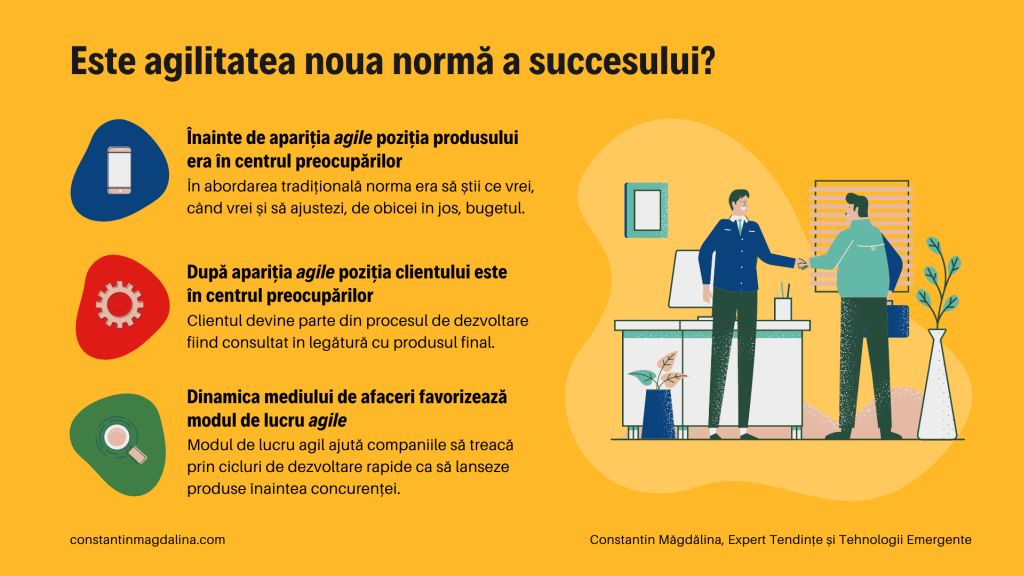
Agility emerged in 2001 in response to the traditional approach to software development. Adherents were guided by the belief that this approach is customer-centric and stimulates teamwork.
In the traditional approach, the norm was to know what you want, when you want, and to adjust your budget, usually down. Customer focus and needs took rank second. First of all, it was about "us and ours".
In the agile approach instead, through iterative work cycles, you maintain the budget and the execution schedule and you adjust the goal to the client's needs. A change of approach that focuses on the beneficiary and not the supplier. How did we get here?
1. Before the emergence of the agile framework, the approach was product-centric
Depending on the industry, there was greater or lesser concern about the product and its quality. The processes were carefully observed and adjusted to eliminate losses, errors and optimize costs.
The project management of product development used to span long periods. One worked in sequences with a very linear and non-collaborative approach to solving activities.
The customer was rather the passive external receiver of a deliverable coming from the company. Quantitative and qualitative research was done to find clearly expressed or latent desires for product development. It's just that the initiatives belonged to the companies. There were restrictions on real-time access to consumer information.
The long duration of the elaboration of the plans and their implementation meant that between the moment of starting the projects and their implementation the needs of the client/consumer changed. In short, the relationship with the customer was a one-way street which presented many disadvantages.
2. After the emergence of the agile framework, the approach is customer-centric
Processes remain important but project management takes place in short development cycles. It is an incremental, software-based approach to software development that focuses more on people, results, collaboration, and flexible responses to change.
Instead of planning the whole project, the development process is broken down into small pieces, completed in iterations or short time intervals. The customer becomes part of the development process being consulted about what is configured in pieces of what will be the final product. In the case of agile, the customer is less and less a category and more and more an individual.
The approach is consultative, inclusive, open to the client, and focuses on the client. The information is captured in real-time, and between the time of its transmission and the time of implementation the intervals are of the order of days and sometimes hours. The relationship with the customer is a two-way street in which information is conveyed from the customer to the supplier and vice versa.
3. More and more industries are impacted by technology and moving to agile
The decisive factor for this transition from the traditional to the agile approach is the widespread adoption of technology in more and more fields. For example, the traditional waterfall project management approach was mainly used in engineering systems in the manufacturing and construction industries. A linear, sequential approach, when one stage flows from another like a waterfall. It is still used today. It is difficult to make the total transition of a construction project to agile; it implies approvals that have been given for the project, legislative constraints, resistance structures that cannot simply be modified as if you were rewriting a line or class of code.
However, with the help of Building Information Modeling technology, the key product, and asset data as well as three-dimensional computer models can be used to efficiently manage information throughout the project lifecycle, from the earliest concept to operation, in an agile manner.
4. The business environment dynamic favors the agile way of working
In today's dynamic business environment, companies across all industries are facing rapidly changing demands from customers, partners, and consumers. Teams need to quickly change their focus, adapting their strategy to meet a new set of goals. For traditional teams, this can be quite a traumatic experience. If a team has been working on a project for a few months, simply abandoning that work can make people feel that their time has been wasted and make them rethink how they approach their new tasks.
But agile teams experience change almost constantly. Each new sprint workflow brings with it a different set of tasks. This makes it easier for agile teams to adapt to change and adapt to changing priorities within an organization. Agile teams are 25% more productive than traditional ones.
The transition to an agile way of working also says something about the intensification of global competition that drives companies to go through rapid development cycles to launch products ahead of the competition. Industries that were traditional make the transition to agile by recognizing the benefits of this approach in terms of speed of placing products on the market. With agile, launching a product/service on the market happens 50% faster.
At the macro level, the global economy lays on new foundations. Services have become increasingly important in the development mix of the world's major economies. A successful economy is a service economy. For relevant services, launched quickly and with significant success rates, the agile approach has proven to be superior to traditional approaches.
About Constantin Magdalina
Constantin Magdalina has 15 years of working experience, while he performed in multinationals both in Romania and abroad. Constantin has a Master’s degree in Marketing and Business Communication from the Academy of Economic Studies in Bucharest. He is certified in Lean Six Sigma and ITIL (IT Information Library®) which provide him a good understanding of processes and transformations within organizations. The Chartered Institute of Marketing certification further complemented his expertise and knowledge in business. In his over 4 years of working activity in a Big4 company, he initiated and conducted studies that analyzed different aspects related to the business environment in Romania. He is the author of numerous articles on topics related to innovation, the efficiency of business processes, social media, the consumers’ buying experience in the age of digital, trends, and emergent technologies. He is invited as a speaker at numerous events and business conferences.





























